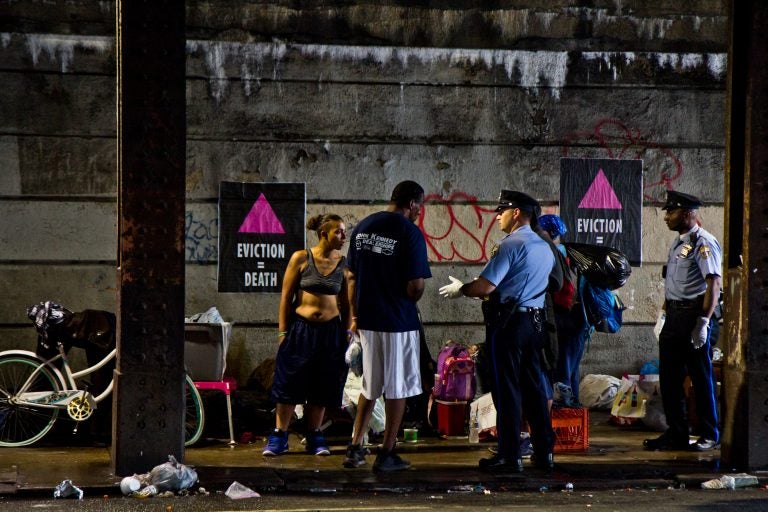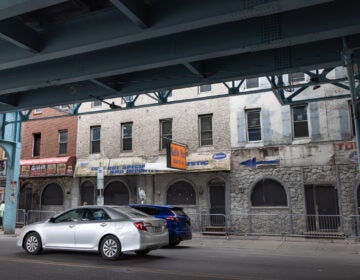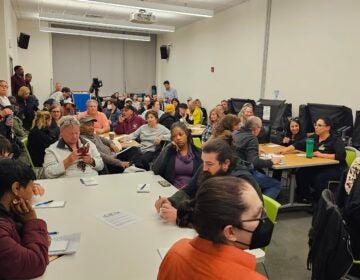Renewing emergency response to opioid crisis, Philadelphia cites progress addressing homelessness, addiction
The move coincides with the first major update on the emergency response to the opioid crisis since the last homeless encampment was closed in Kensington.

Philadelphia police speak to residents of a homeless encampment at Kensington and Lehigh avenues before a scheduled clean out in May 2018. (Kimberly Paynter/WHYY)
The city is renewing its emergency response to the opioid crisis through the end of the year, and with that six month-extension the Philadelphia Resilience Project is offering a snapshot of its progress.
A 38-page report released Wednesday is the first major update on the multifaceted effort since the city closed the last large homeless encampment in Kensington, the epicenter of Philadelphia’s struggle with the addiction crisis.
Progress is cited on seven different fronts seeking to address living conditions that have become intolerable for many neighborhood residents while also providing help for those struggling with addiction. Accomplishments include picking 24,000 discarded needles off sidewalks and streets, establishing safe routes for children walking to six neighborhood schools, and providing shelter for 548 people over a collective total of more than 45,000 nights.
Acknowledged in the report, however, is that opioid addiction and its repercussions remain a massive problem that will take years of sustained effort to resolve.
“I think we’ve made tremendous progress,” said Brian Abernathy, the city’s managing director. “When we started, we had two major encampments that were the site of drugs and prostitution, and we were able to break those encampments up and provide services to the people who were living there.”
Next steps mentioned in the report include finalizing a policy to prevent and address future encampments, expanding needle-exchange programs, and continued distribution of the overdose-prevention drug naloxone and training on how to use it.
Shutting down the homeless encampments that remained at Frankford Avenue and Emerald Street was the top priority when Mayor Jim Kenney signed the executive order that launched the Resilience Project in October. The city took an outreach-intensive approach devised when it closed two other encampments in the neighborhood the previous spring. The idea was not to simply displace vulnerable people struggling with addiction but to get as many of them into housing or treatment as possible.
The encampments have not re-formed, and city officials said they have managed to reduce the street homeless population in the neighborhood overall to about half its peak of about 700 last summer.
But there were still about 500 people in the area sleeping on the street during the most recent weekly count conducted by the Philadelphia Police Department, said Liz Hersh, the city’s homeless services director. She estimated that only about half of those people were part of the area’s regular homeless population, though.
“There are people who come and go, Hersh said. “They come to buy, sell, and use.”
Hersh said the city has expanded capacity in five shelters serving people in addiction by 100 beds since last October, to about 220 total. Both the shelters located in Kensington have been consistently full, according to a representative for Prevention Point, which runs them.
Nicole Bixler, who does outreach work in Kensington through her organization, Operation In My Backyard, said she thinks there isn’t enough shelter capacity in the neighborhood to meet the demand.
She also had lingering questions about where many of the people she encountered at the homeless encampments have ended up since they were closed.
“Everybody’s dispersed,” she said. Many of them, “we haven’t seen in months, and we don’t know where they are.”
Outreach workers compiled a list of the people they engaged with at the encampments, and at the time the last camp was closed in January, about half of them had landed in treatment, shelters, or permanent housing programs.
Hersh couldn’t provide more recent data on the outcomes for those encampment residents but said that roughly half of them haven’t been seen again since the camps were closed.
Though it would be helpful to have more beds in shelters that serve people in active addiction, Hersh said, her top priority was to add more long-term, permanent supportive housing units.
“Building a massive shelter system is not in our plans, she said. “It’s not the answer.”
Moving forward, the report said, the Resilience Project has set a goal of adding 250 permanent supportive housing units each year for the next 10 years, which would amount to the 2,500 Hersh said the city needs to end homelessness.
And street outreach continues.
“Just because the encampments are gone doesn’t mean that we’ve stopped,” she said.
At the start of the Resilience Project, nearly $8 million in new funding was invested through the end of the 2019 fiscal year on behavioral health, homeless, and community services. In his five-year fiscal plan, which goes through 2024, Kenney has called for $36 million in new funding dedicated to the Resilience Project. The report breaks down that funding as $26 million for homeless services, $6.5 million for behavioral health services, $3 million for community services, and $500,000 for the Medical Examiner’s Office.
Rev. Richard Harris, a senior pastor at Firm Hope Baptist Church, located a couple of blocks from the former site of an encampment on Tulip Street, said he had seen a difference in the community since the city’s efforts began.
“I think they’re making an earnest effort against a humongous problem,” Harris said.
Read the report below:
WHYY is your source for fact-based, in-depth journalism and information. As a nonprofit organization, we rely on financial support from readers like you. Please give today.





